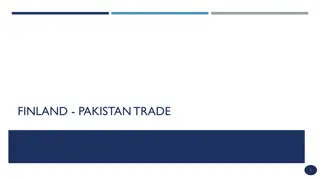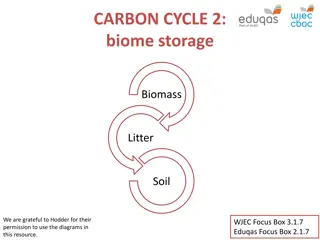Harnessing Carbon Markets for Sustainable Development in Pakistan
Understanding the significance of carbon markets, this content delves into the interplay between economic growth and environmental sustainability, emphasizing the urgency to limit unsustainable practices. It explores mechanisms such as carbon pricing and cap-and-trade systems in the context of climate action, highlighting the need for drastic emissions reduction to achieve global decarbonization targets. The discussion extends to the principles of carbon trading, including carbon credits and offsets, as well as distinctions between compliance and voluntary carbon markets.
Download Presentation

Please find below an Image/Link to download the presentation.
The content on the website is provided AS IS for your information and personal use only. It may not be sold, licensed, or shared on other websites without obtaining consent from the author. Download presentation by click this link. If you encounter any issues during the download, it is possible that the publisher has removed the file from their server.
E N D
Presentation Transcript
Understanding Carbon Markets & Potential for Pakistan
Why Markets for Climate Action? Inextricable linkages between Economic growth and environmental cost to the society with the goal to limit the unsustainable practices Integrating social cost of pollution in full through policies and regulations Internalizing the environmental externalities leading to policies such as: Quantity Regulations Carbon Pricing mechanisms Carbon Taxes, Cap and Trade Mechanisms 1
Paris Decarburization Target & Carbon Markets 50 Mitigation Targets and Financing 40 Drastic emissions reductions required for keeping the global average temp in 1.5 oC range (570 Gtons of GHG global budget) -23 G ton from current Level 30 GHG emissions to be cut by 50% from 2030 and reach to net-zero by 2050 20 Financing gaps to fund the required emissions reductions amounts to trillions - Not possible to be financed from public and/or concessional funding sources 10 0 Net Zero by 2050 2040 2020 2030 2050
Principle of Cap & Trade A market-based approach used to control pollution by setting a ceiling on total pollutant emissions and providing an economic incentive for achieving emissions reductions Participants are allowed to trade emissions reduction permits (aka allowances) in order to make profits from unused allowances or to meet requirements Carbon Credit A financial instrument equivalent to either: (a) the right to emit 1 metric ton of CO2 (an allowance); or (b) the reduction of 1 metric ton of CO2 (i.e an offset) Carbon Offset Offsetting involves reducing net carbon emissions by buying the rights to emissions reductions generated by GHG reduction projects Offsets are project-based emissions reductions and may be used in voluntary or regulated markets
Introduction to Carbon Market Compliance Vs Voluntary Market Voluntary Carbon Market (VCM) is a decentralized market where private actors voluntarily buy and sell carbon credits that represent certified removals or reductions of GHGs Compliance Carbon Markets (CCMs), are set by cap-and-trade regulations. Carbon emission certificates for domestic firms and sectors are issued by governmental organizations or international body (United Nations)C 1
Mechanism of Carbon Trading $$$ $$$ $$$ Government implements carbon pricing mechanism or Emission Reduction Targets With Carbon Pricing the cost of doing business and services increases incentivizing to shift the business to low emissions options CO2 2 Renewable and low energy options becomes more competitive and cheaper and ultimately leads to low emissions 1
From Kyoto to Paris Success and Lessons Learnt from CDM Articles 6, 12 and 17 of the Kyoto Protocol (1997) established the global carbon market CDM established the rules and methodologies for GHG emission reduction quantification, baselines and protocols for monitoring and verification Emissions trading systems facilitated the trading of carbon credits and established the billion dollar global carbon market Success of CDM shows the potential for Article 6 in contributing to the target of Paris Agreement
Voluntary & Compliance Market Specifications Voluntary Market Compliance Market Shifting to low emissions compliance Emission reductions for voluntary commitments Objectives Market Based Price Range: Market Based Price Range: 1$ to 60$ Carbon Pricing Certified Emissions Reductions (CERs) Voluntary Carbon Units VCUs/VERs Product 1
Growth of Carbon Markets in Numbers! 73 Initiatives Carbon Prices Initiatives Implemented Globally 39 National Initiatives Covered in these initiatives implemented 11.66 GtCO2e of Emissions Representing 23% of global GHG emissions 1, 1% 7, 7% 16, 15% 35, 33% 30, 28% 17, 16% North America Europe and C. Asia Latin America East Asia & Pacific Middle East & Africa South Asia
Evolution and Comparative Size of National Carbon Markets 8,000 7.800 Mitigation Share of Carbon Markets Plethora of national carbon markets emerging globally seeing the promise and potential for climate action 6.000 4.500 EUETS is the worlds first functional emissions trading system & 2nd largest system after China 4,000 Chinese Carbon Market is already largest of the world in terms of GHG emissions covered and set to grow exponentially Pakistan can benefit by interlinking with Chinese carbon market 2,000 1.500 580 320 140 0 China Current China Projected UK S. Kores California EU ETS
Carbon Credit Prices Trajectory 100 Carbon Prices as Economic Incentives 80 As of April 1, 2023, around 20 % of global greenhouse gas emissions are covered by a direct carbon price or some carbon pricing mechanism Current carbon prices do not represent the actual price of climate induced impacts Externalities 60 40 20 Carbon prices remain too low over a long period of time for inducing effective climate action 2022 2019 2020 2021 2017 2018 With the Paris Agreement becoming effective and demand for global carbon credits increasing the price for the carbon credits shown an increasing trend and likely to increase in future 1
Advantages of Carbon Markets Flexibility Allows flexibility and choice for the industry to cut their emissions in a cost effective manner Additionality Regulatory requirements compels additional reduction and filters out business as usual scenario Measurability Methodological requirements ensures credibility and measurability through monitoring, reporting and verification Innovation Economic Incentives foster technological innovations for reductions
Typical Cycle of Carbon Reduction Project 03 03 04 04 01 01 02 02 MRV Scoping Implementation Designing/Validation Register project with suitable international carbon standard Setup project management structure Implement MRV system Secure more funding for implementation Secure funding Select carbon assessment methodology and regime Develop Project design documentation including baseline setting Monitoring and Evaluation framework Target Area Assessment Technical and Financial Feasibility studies Project boundary & GHG accounting Ecosystem (ESG) services assessment Implement MRV system as per the registered plan Measure, report and verify Carbon Trading of carbon and monetization Sharing of revenues
Carbon Market - Potential for Pakistan Pakistan has substantial potential for emission reductions in energy, transport, industry, agriculture and other sectors Marginal abatement cost in Pakistan considerably lower than many other parts of world Committed to reduce 50% of its overall projected emissions by 2030 Substantial needs for Financing both for mitigation as well as adaptation purposes Article 6.4 can translate the financing through transaction of untapped emission reduction Pakistan needs to set-up institutional and procedural frameworks
Potential in Corporate Sector 24 Companies voluntarily declared to become NetZero by 2030 or 2050 Vibrant Sustainability objectives set by Corporate Sector where reducing carbon footprints is one essential goal Export oriented companies shall have to comply with a range of international standards such as CBAM Energy Sector alone offers a substantial potential for emissions reduction currently represents nearly 40% of Pakistan GHG emissions Carbon financing can provided the much needed financing for the corporate sector
NDRMF Role & Support Supporting Carbon Markets in country part of NDRMF Strategic Framework and mid to long term Strategy Assist and support Government Bodies for establishing policy and regulatory frameworks for integrating carbon markets as part of climate action program Working with private sector and assisting in aligning their Sustainability and Carbon Emissions goals with international regulatory requirements Develop guidance tools and instruments for different industries on technical aspects of Carbon Markets Facilitate hands on training on Methodologies for Carbon Quantifications, develop projects and assist in Sale of Carbon Credits And much more .. 1
Questions & Discussion http://: www.ndrmf.pk Follow NDRMF on: 1























